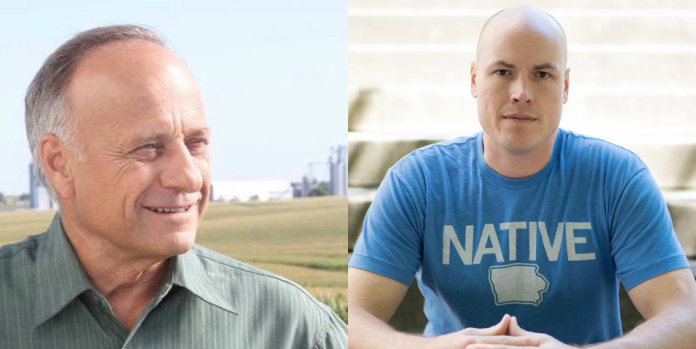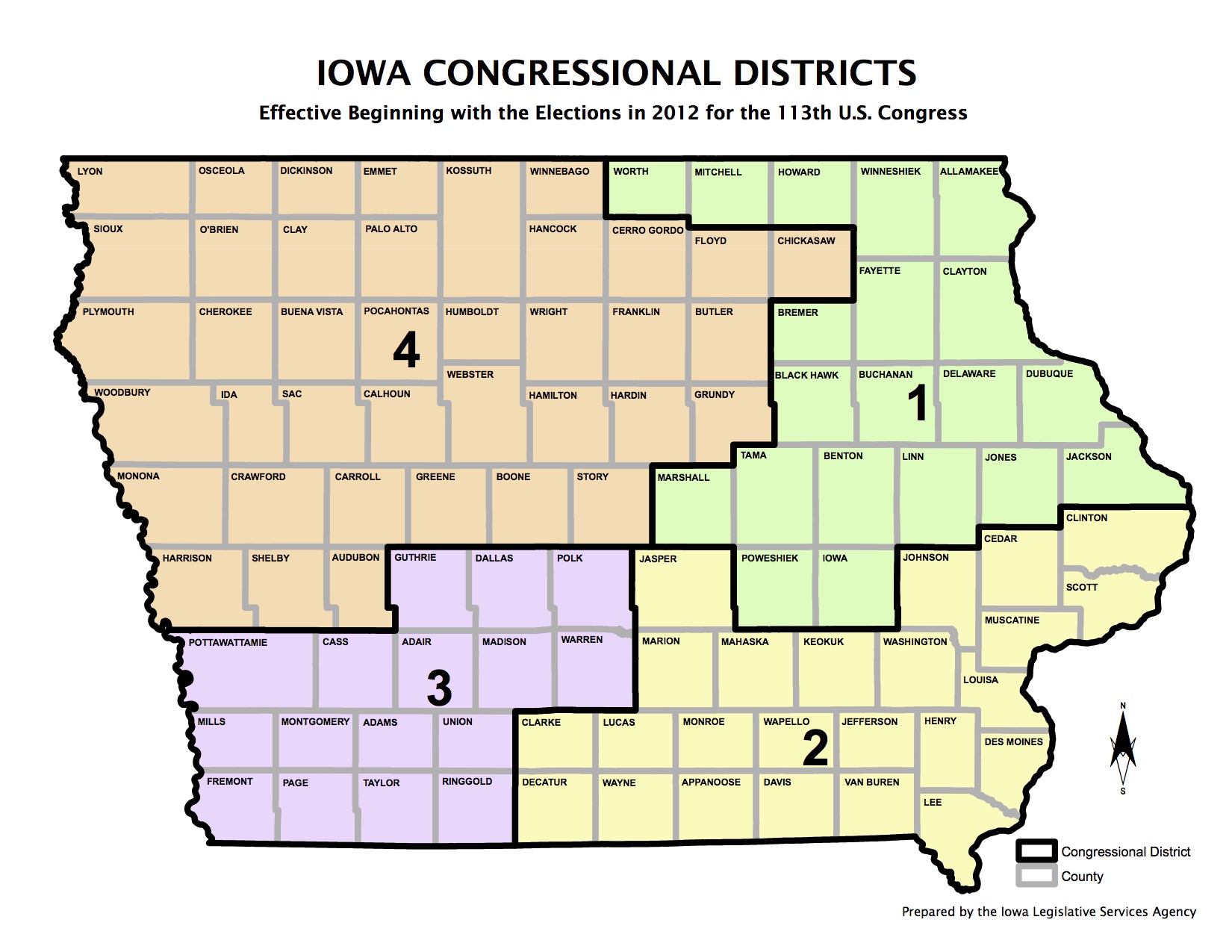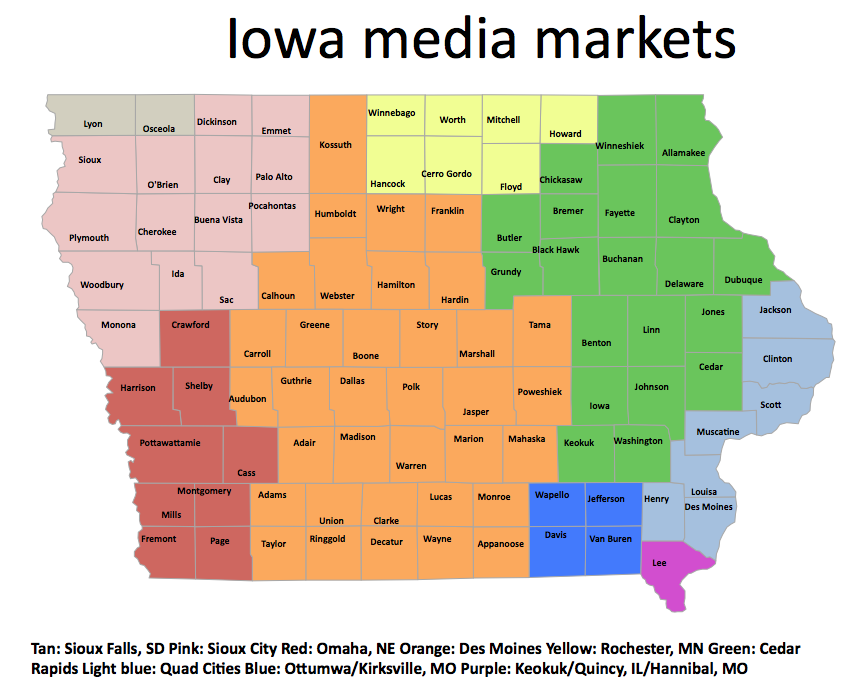Representative Steve King is making national news again, this time for re-tweeting a neo-Nazi British politician. King’s long had a thing for European right-wingers who stir up racist fear about non-white immigration. As usual, no House Republicans are calling for King to resign, nor has any prominent Iowa Republican denounced the sentiments. King repeated his warning about immigration this morning.
J.D. Scholten won the Democratic nomination in Iowa’s fourth Congressional district convincingly with 51 percent of the vote in a three-way field. He will be the underdog in November. All the major election forecasters rate this district as safe for Republicans, since King won more than 60 percent of the vote in 2014 and 2016.
On the other hand, a few months ago, a Democrat won a special election in a Pennsylvania U.S. House district with a partisan voting index of R+11–the same as IA-04. More recently, a Republican barely won a special election in an R+13 Arizona House district.
Here’s what Scholten needs to pull off what would be a huge upset:
1. About 140,000 to 150,000 votes in November.
In the last midterm election, King defeated Jim Mowrer by 169,834 votes to 105,504. (Iowa still had five Congressional districts in 2010, so fewer votes were cast in King’s race.)
Assuming some 280,000 to 300,000 people cast ballots in IA-04 this year, Scholten will need support from approximately 35,000 to 45,000 Iowans who did not vote for Mowrer.
Incidentally, 14,588 Iowans voted for Scholten in the primary, according to unofficial results. Total Democratic turnout in IA-04 this month was 28,487.
2. Record-breaking Democratic turnout.
The latest voter registration totals indicate that the 39 counties in IA-04 contain 116,129 active registered Democrats, 188,334 Republicans, and 174,599 no-party voters. The total number for each party, including “inactive” registered voters, is 125,298 Democrats, 197,578 Republicans, and 191,491 no-party voters. (Those numbers will change a little due to people changing their registration on June 5 to vote in the primary.)
Obviously, there aren’t enough registered Democrats in the district for Scholten to win just by maximizing his own party’s turnout. Nevertheless, strong GOTV would make a big difference.
About 56.5 percent of registered Iowa Democrats cast ballots in the 2010 general election. About 56.7 percent did so in 2014.
Assuming roughly the same turnout level, Scholten can count on a little more than 70,000 Democrats in IA-04 participating in this year’s election. That would probably work out to only about a quarter of the total ballots cast.
Increasing base Democratic turnout to 65 percent would net Scholten an extra 10,000 votes. That would be very high for a non-presidential year. Some 62.2 percent of registered Iowa Democrats cast ballots in 2006, which was a wave year for the party.
Since the June 5 primary saw record levels of Democratic participation, it’s not farfetched to expect unusually strong engagement this fall in reaction to an unpopular Republican president and the failures of GOP governance in Iowa.
3. A large number of Republicans defecting from King.
About 68.2 percent of registered Iowa Republicans voted in the last midterm election, and 69.0 percent did in the 2010 GOP landslide. In 2006–a wave year for Democrats–GOP turnout was only slightly lower: 64.9 percent.
Assuming between 65 percent and 70 percent of registered Republicans vote this fall, between 128,000 and 138,000 Republicans in the IA-04 counties will cast ballots. If they all support King, that would give him almost enough to win.
A non-trivial number of Republicans are fed up with King, though. State Senator Rick Bertrand won about 35 percent (15,872 votes) in his 2016 GOP primary challenge, even though practically the whole state GOP establishment backed King. Cyndi Hanson won about 25 percent (9,368 votes) in this year’s IA-04 primary–a high number considering she raised almost no money and had no direct mail or paid media program.
Ideally, Scholten would win crossover votes from disaffected Republicans. But some may not have the stomach to vote for a Democrat. Every Republican who leaves that ballot line empty or votes for a third-party candidate (Charles Aldrich has filed as a Libertarian here) is half as good as a Republican who marks a ballot for Scholten.
I’m curious to see how often Governor Kim Reynolds campaigns alongside King. She endorsed him before the 2016 primary and welcomed him as one of her campaign co-chairs last November. During King’s toughest re-election race against Christie Vilsack in 2012, Governor Terry Branstad cut a radio ad for the GOP incumbent. But Branstad wasn’t on the ballot that year. Reynolds has a tough race on her hands against Fred Hubbell.
Picking numbers out of the air, let’s say 10 percent of GOP voters support Scholten in November and another 15 percent decline to vote for King. That scenario still leaves Scholten below 100,000 total votes.
4. A solid majority among independents.
Turnout drops much more sharply among no-party voters in non-presidential years than it does among partisans. Only about 35.6 percent of independents cast ballots in the 2006 general election, 36.5 percent did in 2010, and 37.8 percent did in 2014.
Assuming turnout between 35 and 40 percent this year, roughly 67,000 to 76,000 voters affiliated with neither Democrats nor Republicans will vote in the IA-04 counties. Scholten needs a commanding margin–say, 65 to 70 percent of them–to get him a majority of all votes cast.
5. Resources to campaign district-wide.
Money alone will never win this district for Democrats. Vilsack raised and spent more than $3 million in her 2012 race against King, and Mowrer raised and spent more than $2 million two years later.
At the same time, name recognition is essential for a challenger facing an eight-term incumbent, even a toxic one. IA-04 covers a huge area: 39 counties, spread over five media markets. Here’s the Congressional map:
And here’s the map of media markets:
Scholten cut a good television commercial before the primary, acknowledging that many consider King “unbeatable.”
My transcript:
Scholten’s voice: The average person in Congress is 58 years old, with a net worth of a million dollars.
Well, I’m different. I’m 20 years younger, and just shy of a million dollars short of that average.
My name is J.D. Scholten, and in Iowa’s fourth district, it’s time for change.
Youthful stubbornness, an athlete’s energy, and a passion for helping others is a dangerous combination.
Tell me this race is unwinnable. Tell me Steve King is unbeatable, and it only adds fuel to my fire.
My name is J.D. Scholten, and I approve this message.
That spot only aired for about a week in part of the district. To support Scholten’s ability to buy television and radio time during the general election, you can donate here.
Any comments about the IA-04 race are welcome in this thread.




2 Comments
He needs a strong Farm Bill Strategy, for the Rural Vote
Republicans claim that free markets work for agriculture, but the evidence is clear and strong that they don’t. This thenhas translated into a Republican federal farm policy that reduced (1953-1995) and eliminated (1996-208) the minimum farm Price Floors and supply management from the Democratic New Deal. Republican farm bills, therefore, have been anti-farmer, with market prices usually below full costs, where we lose money on foreign sales, subsidize CAFOs, including the Chinese and Brazilians that have owned as much as 30% of US hogs, (40 corps now own more than 2/3). So most farmers have lost value added livestock in this process. Kings IA-4 distict is one of the biggest in the country for these impacts, and it can be seen in the devastation of the rural towns all across the district, as Iowa agriculture has changed into a system that creates much less wealth, especially for the district. Adjusted for inflation, Iowa net farm income in 2016 was only 33% of what it was at the height of the New Deal, (1942-1952 when US agriculture achived 100% of parity or more every single year). That’s in spite of much much greater corn and soybean yields. All of this then translates into Republican farm bills that, while doing nothing for farmers, cost twice as much as true Democratic farm bills, (big spenders!). In all of this King looks terrible to Republicans and Independents, especially rural ones. But that’s true only if there is leadership from Scholten. If Scholten concedes the farm vote to King, (by remaining silent on federal anti-farmer policies,) he won’t win.
brad-wilson Tue 19 Jun 1:17 PM
I read somewhere very recently...
…that traditionally, Republicans are good at farm politics but terrible at farm policy, while Democrats are very good at farm policy but not good at farm politics. We need to get better at farm politics.
PrairieFan Wed 20 Jun 2:14 AM